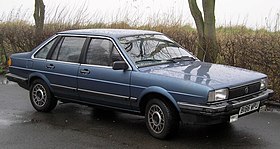Volkswagen Santana
| Volkswagen Santana | |
|---|---|
 |
|
| Overview | |
| Manufacturer |
Volkswagen Nissan Shanghai Volkswagen Automotive |
| Also called | Shanghai-Volkswagen Santana Volkswagen Quantum Volkswagen Corsar Volkswagen Carat Volkswagen Passat Nissan Santana Ford Versailles |
| Production | 1981-present |
| Assembly |
Argentina Brazil China Germany Japan Mexico |
| Body and chassis | |
| Class | Mid-size car |
| Body style | 2-door saloon/sedan (Latin America) 4-door saloon/sedan 5-door estate/wagon |
| Layout | Front-engine design |
| Platform | Volkswagen Group B2 platform |
| Related | Volkswagen Passat (B2) |
The Volkswagen Santana is a three-box sedan, based on the second-generation Volkswagen Passat (B2). It was introduced in 1981. The use of the "Santana" badge rather than "Passat" echoes the use of different names for the sedan versions of the Polo (Derby) and Golf (Jetta).
In North America, it was also known as the Volkswagen Quantum. In Mexico, it was named the Volkswagen Corsar, while in Argentina it was sold as the Volkswagen Carat. In Brazil and other South American countries it was known as the Santana, while the Passat Variant B2 wagon was marketed as the Volkswagen Quantum. In Europe, the Santana name was dropped in 1985 (with the exception of Spain, where the Santana nameplate was retained) and the car was sold as a Passat. European production ended in 1988.
The final Chinese versions are named Santana Vista, and the name Santana is used on a new 2013 model, slightly smaller and based on the Škoda Rapid and SEAT Toledo.
The Santana's biggest success was in China. The Santana (B2) had been built in China on a small scale trial basis by the Shanghai Tractor Automobile Corporation (STAC), predecessor of the SAIC group, since 1982. The first 100 cars were built from CKD kits delivered from Germany. In 1984, Volkswagen signed a contract with STAC, along with the China National Automotive Industry Corporation (CNAIC) and the Bank of China to form the Shanghai Volkswagen Automotive joint venture in October 1984. The first assembly line of the Santana started in October 1985. In September 1986, the 10,000th Santana was built in China. The car and venture laid the ground-works for China's mass motorization. The drive to fully localize production became the impetus for the Chinese auto parts industry: In 1986, the quota of made-in-China parts was below six percent. In 1995, the local content quota stood at 89 percent.
...
Wikipedia
